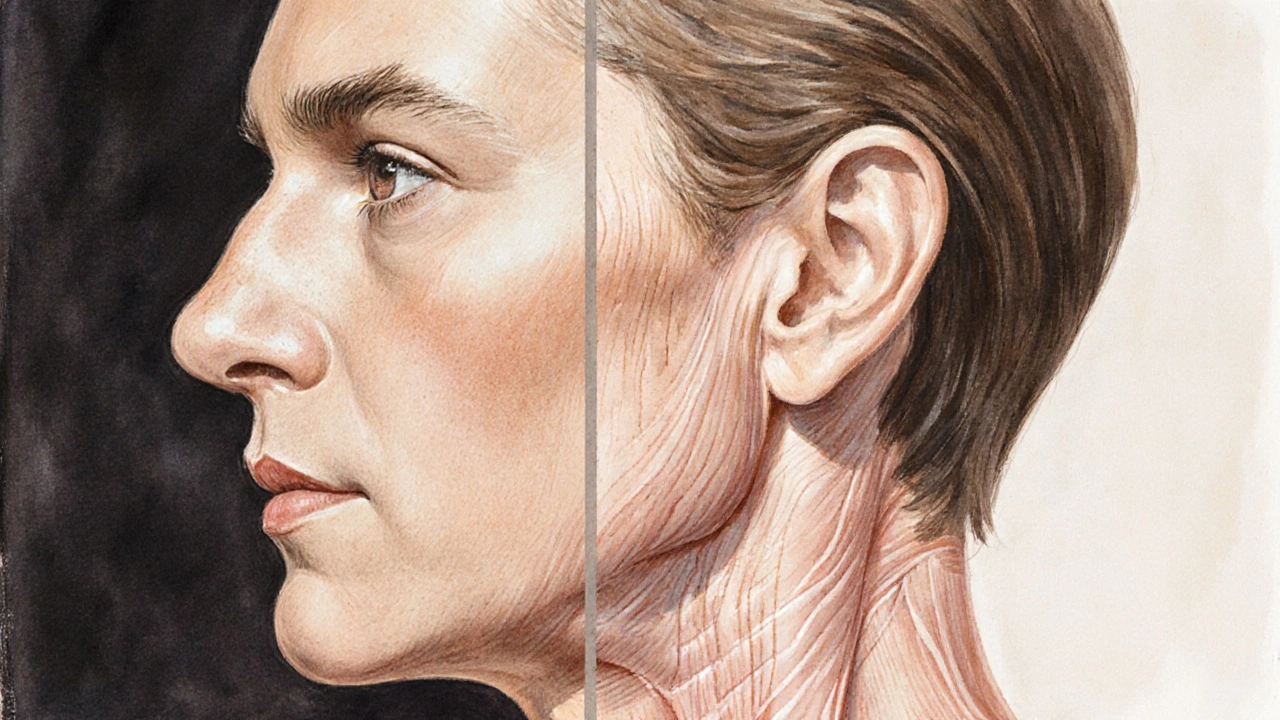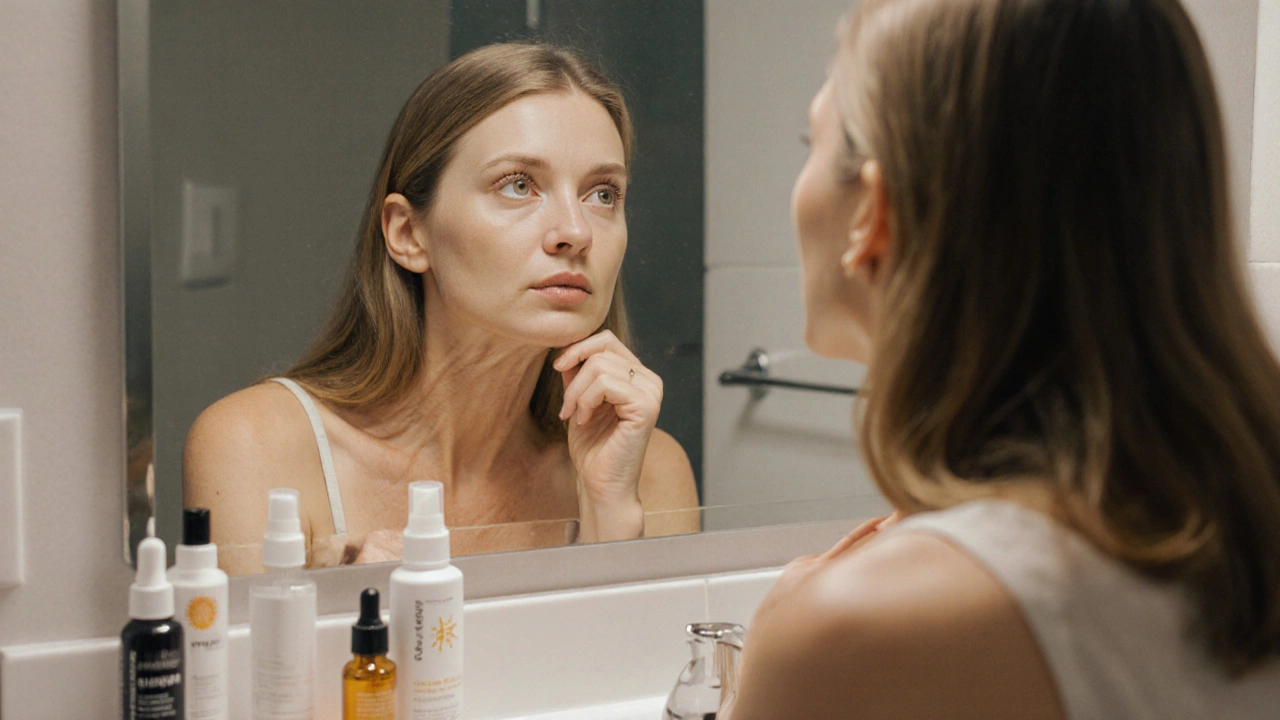Jowl Risk Calculator
This tool estimates your risk of developing noticeable jowls based on your lifestyle and genetic factors.
Most people don’t notice jowls until they’re already there. You look in the mirror one day and realize your jawline doesn’t look the same as it did five years ago. The skin under your chin sags slightly. Your profile looks softer, less defined. It’s not a sudden change-it creeps up slowly, often starting in your late 30s or early 40s. But here’s the thing: jowls don’t just appear out of nowhere. They’re the result of years of skin changes, muscle weakening, and gravity doing its job.
When Do Jowls Actually Start?
Jowls typically begin forming in your late 30s to early 40s. That’s when collagen and elastin production drops noticeably. Your skin starts losing its firmness, and the fat pads under your jaw begin to shift downward. For some, it shows up as early as 35. For others, it’s not until 50. Genetics, lifestyle, and sun exposure all play a role.
Women often notice jowls earlier than men because female facial fat distribution changes more dramatically after menopause. Estrogen levels drop, which affects skin thickness and elasticity. Men tend to hold onto jawline definition longer because their skin is thicker and their facial muscles are generally stronger. But that doesn’t mean men are immune-many men in their 50s see the same softening of the jawline.
It’s not just age. If you’ve spent years in the sun without sunscreen, smoked, or had significant weight fluctuations, jowls can show up sooner. Skin that’s been stretched by rapid weight gain and then lost doesn’t bounce back the same way. Think of it like a stretched rubber band-it loses its snap.
What Causes Jowls to Form?
Jowls aren’t one single problem. They’re the result of four main factors working together:
- Loss of collagen and elastin - These proteins keep skin tight. After 25, your body makes about 1% less collagen each year. By 40, you’ve lost nearly 20%.
- Fat redistribution - Facial fat doesn’t just disappear. It moves. The fat that once sat high on your cheekbones starts sinking toward your jawline, adding bulk where you don’t want it.
- Weakness in the platysma muscle - This thin muscle runs from your chest up to your jaw. Over time, it loosens and pulls downward, creating the band-like sag you see under your chin.
- Gravity - It’s not just a cliché. Gravity pulls everything down. Without strong skin and muscle support, the lower face loses its structure.
These changes happen gradually. You won’t wake up one morning with jowls. Instead, you might notice your neck looks fuller in photos, your profile seems less sharp, or your chin looks less defined when you smile.
How to Tell If You’re Developing Jowls
Here’s a simple test: stand in front of a mirror and tilt your head back slightly. Look at your jawline. If you see a soft curve instead of a clear angle from your ear to your chin, you’re likely seeing early jowls. Another sign? When you smile, the skin under your chin doesn’t tighten-it droops.
Take a side photo of yourself every six months. Compare it to older ones. Small changes add up. If you notice your jawline is less defined than it was two years ago, you’re not imagining it.
It’s also worth checking your neck. Jowls often go hand-in-hand with a loss of neck definition. The line between your jaw and neck should be crisp. If it’s blurred or shadowed, that’s a clue.

Can You Prevent Jowls?
You can’t stop aging, but you can slow down the factors that make jowls worse.
- Wear sunscreen daily - UV damage breaks down collagen faster. Even on cloudy days, UV rays penetrate your skin. Use SPF 30 or higher on your face and neck.
- Stay hydrated - Dry skin looks looser. Drink enough water and use a hydrating serum with hyaluronic acid.
- Don’t smoke - Smoking cuts off oxygen to skin cells and accelerates collagen loss. It’s one of the biggest accelerators of facial aging.
- Maintain a stable weight - Rapid weight loss or gain stretches and then collapses skin. Consistency helps your skin stay resilient.
- Strengthen facial muscles - Facial exercises, like chin lifts or cheek squeezes, can help tone the muscles under your jaw. Studies show consistent practice over 20 weeks can improve jawline definition.
Skincare products alone won’t reverse jowls, but they can help. Look for retinoids (like tretinoin), peptides, and vitamin C. These ingredients boost collagen and improve skin texture over time. Prescription retinoids are the most effective-over-the-counter versions work, but slower.
What Treatments Actually Work?
If jowls are already noticeable, you have options. Not all treatments are equal. Here’s what science and dermatologists agree on:
- Ultherapy - Uses focused ultrasound to tighten skin from within. Works best for mild to moderate jowls. Results show up over 2-3 months and last about 1-2 years.
- Radiofrequency (RF) devices - Like Thermage or InMode. Heat the deeper layers of skin to stimulate collagen. Good for early jowls. Requires multiple sessions.
- Thread lifts - Tiny dissolvable threads are inserted under the skin to lift and hold tissue. Less invasive than surgery. Results last 1-2 years. Risk of visible threads or asymmetry if done poorly.
- Injectables - Fillers like hyaluronic acid can be placed along the jawline to restore definition. Not a lift, but a contour fix. Lasts 6-12 months.
- Surgical neck lift - The only permanent solution. Removes excess skin and tightens muscles. Recovery takes 2-4 weeks. Best for advanced jowls or when skin is very loose.
Most people start with non-invasive options. Ultherapy and RF treatments are popular because they require no downtime. If you’re in your 40s with mild jowls, these can delay the need for surgery. By your 50s or 60s, surgery often becomes the most effective long-term fix.
What Doesn’t Work
There’s a lot of hype around at-home gadgets and miracle creams. Be careful.
- Facial rollers - They feel nice, but they don’t tighten skin or lift tissue.
- Over-the-counter creams labeled "jowl-reducing" - These can hydrate, but they can’t rebuild collagen deep enough to lift sagging skin.
- DIY exercises from TikTok - Some can strain muscles or even worsen the look if done incorrectly.
Don’t waste money on quick fixes. Real results come from proven methods, not viral trends.

When to See a Professional
If you’re noticing jowls in your late 30s or 40s and they’re bothering you, it’s not too early to consult a board-certified dermatologist or facial plastic surgeon. They can assess your skin’s elasticity, fat distribution, and muscle tone to recommend the right approach.
Don’t wait until you’re embarrassed to take action. Early intervention means less invasive treatments and better results. A single Ultherapy session in your 40s can delay the need for surgery by a decade.
It’s Not Just About Looks
Jowls aren’t just a cosmetic concern. They can affect how you feel about yourself. People often say they feel older than they are when they see jowls in photos. That emotional weight matters.
Taking steps to address them isn’t about chasing youth. It’s about feeling confident in your own skin-no matter your age. The goal isn’t to look 25 again. It’s to look like the best version of yourself at 45, 55, or 65.
Do jowls get worse with age?
Yes, jowls typically get more pronounced with age. As skin continues to lose collagen and muscle tone weakens, the sagging becomes deeper and more noticeable. Weight gain, sun damage, and lifestyle factors can speed up the process. Without intervention, jowls can progress from mild softening in your 40s to significant drooping by your 60s or 70s.
Can losing weight get rid of jowls?
Losing weight might make jowls look worse if you’ve already lost skin elasticity. When fat pads shrink, the loose skin underneath doesn’t tighten up-it just hangs. Rapid weight loss often leads to more noticeable jowls. Slow, steady weight loss combined with skin-tightening treatments is a better approach.
Are jowls the same as a double chin?
No. A double chin is caused by excess fat under the chin, often linked to weight. Jowls are caused by skin laxity, fat redistribution, and muscle weakness. You can have jowls without a double chin, and vice versa. Some people have both. The treatments differ: fat reduction (like Kybella) helps double chins, while skin tightening (like Ultherapy) helps jowls.
Is it normal to have jowls in your 30s?
Yes, it’s normal. While jowls are more common in the 40s and 50s, genetics, sun exposure, and lifestyle can cause them to appear in your 30s. If you’ve had significant sun damage, smoked, or experienced weight fluctuations, early jowls are not unusual. It doesn’t mean something’s wrong-it just means your skin’s aging faster than average.
Can facial exercises really reduce jowls?
Yes, but only with consistent, correct practice. A 2018 study in JAMA Dermatology found that participants who did 30 minutes of facial exercises daily for 20 weeks saw improved muscle tone and fuller cheeks. The effect was subtle but measurable. These exercises won’t replace medical treatments, but they can help maintain definition and slow further sagging.
What’s Next?
If you’re noticing changes in your jawline, start with prevention. Sunscreen, hydration, and avoiding smoking are the cheapest, most effective tools you have. If jowls are already visible, don’t panic. There are safe, proven treatments that can restore definition without drastic surgery.
The key is acting before it becomes severe. Early care means simpler, less expensive solutions. Waiting too long often leads to more invasive procedures. You don’t need to rush into surgery. But you also don’t need to accept jowls as inevitable. With the right approach, you can keep your jawline looking strong-no matter your age.

